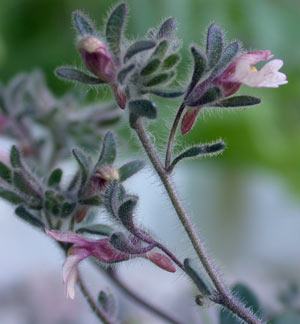Mallorca - Island characteristics overview

Chaenorrhinum origanifolium subsp. rodriguezii
(Photo: M. Vicens)

Dorycnium fulgurans (Photo: M. Vicens)

Launaea cervicornis (Photo: M. Vicens)
Mallorca is the biggest and the most central island of the Balearic Archipelago. It has an area of 3,667 km2, with a mountainous and a flat area.
The mountainous area, in the north-western part of the island, is formed by the range 'Serra de Tramuntana' which extends to about 80km length and which includes the two biggest peaks: Puig Major (1,445m a.s.l.), and Puig de Massanella (1,342m a.s.l.). In the eastern part of the island, there is the range 'Serra de Llevant' (maximum altitude 562m a.s.l.). The Serra de Tramuntana mountain range is a UNESCO World Heritage Landscape. Most of endemic, rare and endangered species of the island can be found there.
The geology of the island is of limestone origin with a characteristic karstic relief in some mountainous areas or rocky coastline. The carbonatic lithologies, occurring almost continuously since the Middle Triasic to the present, feature a geomorphological wide range of endo- and exokarstic morphologies. These lithologies have been extensively affected by a Paleocene complex tectonic phase which acted from the to the Middle Miocene, framed within the context of the western Mediterranean plate tectonics, which caused a strong orography.The basins (El Pla and Migjorn) are filled with deposits from the Miocene to Quaternary. (in the center and the south of the island)
Mallorca´s climate is typically Mediterranean, with warm average temperatures and seasonal rains, the summer period being both hot and dry. The annual rainfall varies across the island, from 350 mm in the south to 1.500 mm in the high areas on the Serra de Tramuntana mountain range. However, most of the island receives between 450 mm and 650 mm of precipitation over the year. 40% of the annual total falls in autumn, between September and November; 25% falls in spring, between March and May; 25% falls in winter, from December to February; and summer, from June to August, sees just 10% of the yearly rain. The island´s rainfall is characterised by its irregularity, varying radically from one year to the next, even reaching the point where there are drought conditions. Most of the rain that falls is concentrated within a few days of precipitation, with some very heavy rains in autumn and lighter rains over the rest of the year. Excluding the high mountain areas, the average annual temperature is between 16ºC and 18ºC, with a maximum summer average of 29ºC to 31ºC and a minimum average winter night-time temperature of 5ºC to 9ºC, although temperatures of over 35ºC and below -2ºC are recorded almost every year, and temperatures occasionally reach 41ºC in summer and fall to -6ºC in winter.
Vegetation and habitats
The vegetation includes a series of endemic species mainly in the mountains. In the highest peaks, a community of spiny-pin cushions can be found which also appears in other places such as littoral areas where the influence of the wind is similar. Several habitat factors (wind, grazing, high insolation and a low soil depth) favour the formation of low-growing shrubs with low density, harbouring many endemic species (for example Astragalus balearicus, Hypericum balearicum, Teucrium asiaticum, and Teucrium balearicum).
Holm oak (Quercus ilex) woodlands are located in mountain areas with high rainfall (over 600 mm) and north orientation. The ground of the oak forest is not very diverse compared to that of other regions, but is rich in endemic species like Cyclamen balearicum or Rubia balearica. These woodlands have long been exploited by man, which has reduced their surface area. There are also large sections of Aleppo pine (Pinus halepensis) forests, which in some spots has replaced the holm oak (Quercus ilex) woodlands.
The Oleo-Ceratonion has a large distribution, mainly because of its adaptation to an extensive climatic variety, especially at dry areas. Ampelodesmos mauritanica dominates in altered natural sites, with preference to mountainous areas and in areas affected by fire and prescribed burning.
Wetland vegetation depends on the quantity of water and its salinity; in this way we can find mainly species like Phragmites australis or Juncus maritimus. On gorges it is usual to find tree and shrub species also present on mountain ridges like laurel and honeysuckle.
The dune vegetation in sandy coast areas belongs mainly to plant communities of the phytosociological class Ammophiletea, with characteristic species like Ammophila arenaria, Cakile maritima, Crithmum maritimum, Eryngyum maritimum, Pancratium maritimum, with some woody species like Juniperus phoenicea or Juniperus oxycedrus subsp. macrocarpa.
At rocks along the coast, one can find halophytic vegetation with fleshy leaves like Silene sedoides, or with salt glands like the genus Limonium ssp. among others features. Some characteristic and endemic species are Launaea cervicornis, Daucus carota subsp. majoricus, and Dorycnium fulgurans.
The rock vegetation has special characteristics to be able to live in rocky places with high erosion processes. In such rocky places, one can find most of the endemic species, for example Brassica balearica, Bupleurum barceloi, Crepis triasii, Pimpinella tragium, Viola jaubertiana, Dianthus rupicola subsp. bocchoriana, Globularia cambessedesii, Helichrysum ambiguum, and Hippocrepis balearica.




